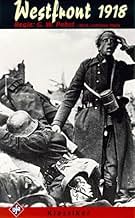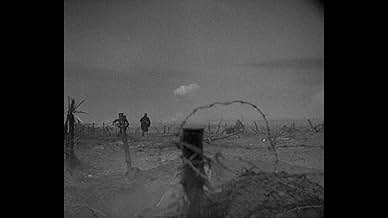Quatre de l'infanterie
- 1930
- Tous publics
- 1h 15min
Un groupe de soldats allemands de la Première Guerre mondiale vit dans les tranchées en France. Karl, l'un d'eux, rentre chez lui en permission et découvre la pauvreté à laquelle sa famille ... Tout lireUn groupe de soldats allemands de la Première Guerre mondiale vit dans les tranchées en France. Karl, l'un d'eux, rentre chez lui en permission et découvre la pauvreté à laquelle sa famille a été confrontée mais doit retourner au front.Un groupe de soldats allemands de la Première Guerre mondiale vit dans les tranchées en France. Karl, l'un d'eux, rentre chez lui en permission et découvre la pauvreté à laquelle sa famille a été confrontée mais doit retourner au front.
- Réalisation
- Scénario
- Casting principal
- Récompenses
- 1 victoire au total
- Der Student
- (as H.J. Moebis)
- Undetermined Secdondary Role
- (non crédité)
- Hamburger
- (non crédité)
- Undetermined Secondary Role
- (non crédité)
- Meal Orderly
- (non crédité)
- Undetermined Secondary Role
- (non crédité)
- Undetermined Secondary Role
- (non crédité)
Avis à la une
It handles all different kinds of aspects from the war. It doesn't only show the situation from the viewpoint of the young soldiers but it also focuses on the family and girls back home. It doesn't do this by featuring it too prominently but picks out an handful of minor characters and just a couple of sequences to get the message across. This works out really well and it doesn't feel melodramatic or anything like that. Modern movies can really learn something from this.
But of course foremost the movie gets set in the trenches, somewhere in France. The movie is filled with some WW I battle sequences, which are all surprising good and authentic looking. Guess lots of materials and places from WW I were still around during the production of this movie so they did not have an hard time recreating the look and feeling of the battles fought out in the trenches.
It was the first sound movie from Georg Wilhelm Pabst and this shows. Nothing too major, it are just some little things showing you that 'talkies' hadn't been around yet for very long and Georg Wilhelm Pabst wasn't also too experienced with it yet. He pretty much shot this movie in the same way as he would had filmed a silent movie.
The movie is of course also original with the fact that it tells the story from the German point of view. While watching this movie you don't actually ever give you the feeling you're watching the movie from the 'evil' and bad point of view. All parties are more or less victims within a war and things are not as black & white as they always seem.
Simply a real good and effective WW I production, especially when considering that it got shot way back in 1930.
8/10
http://bobafett1138.blogspot.com/
This film transcends the limitations of the sensibilities of the time and the special effects available to movie makers. It makes no sweeping statements or judgments about war and aggression. It simply gives you a glimpse of what it was like to live and die in the trenches of The Great War.
Although not as intense as "All Quiet on the Western Front" (whose subject matter it shares), it has its moments of artistry. It is also more narrowly focused than "All Quiet..", but its story is compelling and riveting. Should be in anybody's serious list of worthy war movies.
There is no particular story to focus on. The film is a sequence of events during wartime and it just carries on after the film has ended, just like it was already in existence once the film had started. It does have dramatic segments, eg, the home visit granted to Gustav Diessl (Karl), the exploits involving Hans-Joachim Mobis (the student) and various battlefield situations, confrontations and realizations.
The film occasionally has slow segments but it is interesting from a social history perspective. What was the point of it all?
I have to say though, the impact of it all was a little lessened because the images and concepts weren't as novel for me 90 years later, as unfair to the film as that might be. It lags as well when it's off the battlefield, showing among other things an uninteresting (and long) performance at a canteen, and the confrontation with the wife in bed with another man. I think it was trying to balance out the warfare and build up characters so that we were invested in them, but I struggled to stay interested (this and the bleakness of the thing make it one I wouldn't reach for again). Kudos to Pabst for making it, and I loved the way he closes it with "The End?!", certainly well aware of growing militarism and possibility for another devastating war.
Le saviez-vous
- AnecdotesThis film was banned by the Nazis after they came into power in Germany in 1933.
- GaffesThe depth of the trenches is inaccurate. In several scenes where the soldiers are standing up, their heads are higher than the top of the trench, making them easy targets for snipers and also allowing the French to monitor troop movements.
- Citations
Woman in rationed food line: What are you doing? Back of the line!
Another Woman in rationed food line: What's wrong with the old cow? Cutting in line!
Man in rationed food line: Leave the woman alone.
Woman cutting in rationed food line: My Adolf is dead.
Woman in rationed food line: Think you're the only one? That's no reason to cut in line. Go to the back!
- ConnexionsEdited into A Hellish Chaos (2017)
Meilleurs choix
- How long is Westfront 1918?Alimenté par Alexa
Détails
- Date de sortie
- Pays d’origine
- Langues
- Aussi connu sous le nom de
- Westfront 1918
- Lieux de tournage
- Sociétés de production
- Voir plus de crédits d'entreprise sur IMDbPro
- Durée1 heure 15 minutes
- Couleur
- Rapport de forme
- 1.20 : 1














